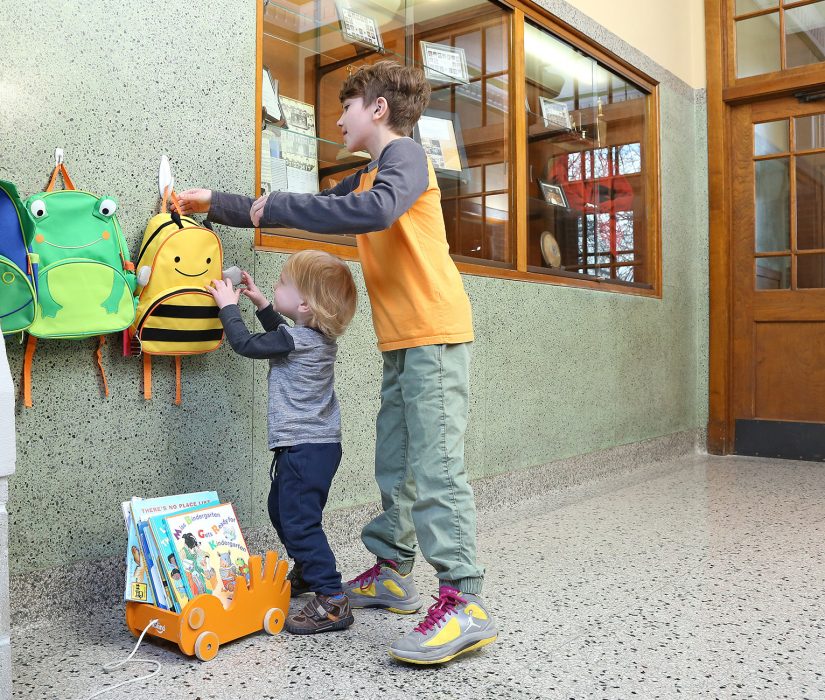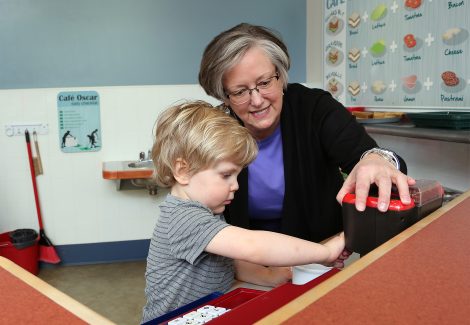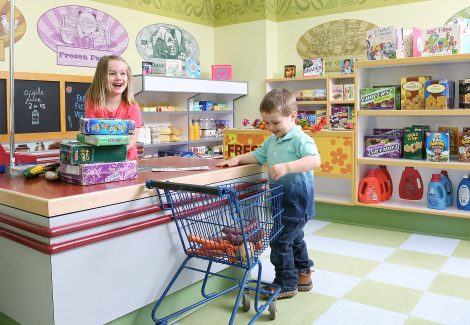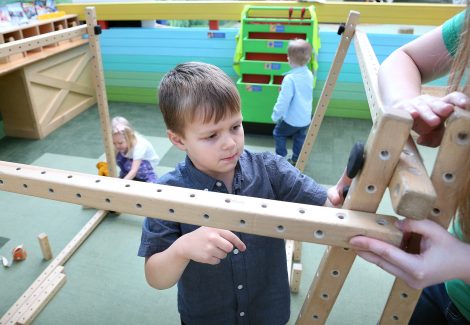1 of 29
Under the Hood
Get ready for a road trip. Here, busy mechanics change tires, batteries, oil, and mufflers. Customer service workers take orders, answer phone calls, and settle bills for service completed.
While working under the hood, visitors may:
- Slide underneath the car on a creeper to change the ‘rusty’ muffler and tailpipe.
- Balance the tires using lug nuts and a pneumatic drill.
- Put a personal touch on the license plates on both the front and the back of the car.
- Match and sort the “tools of the trade,” including wrenches, screwdrivers, and space parts
- Plan and manage your workday, using a changeable wall clock, work order on clipboards, and a telephone.
2 of 29
Whiskers & Tails
Take good care of your furry friends. While playing in Whiskers & Tails, guests may:
- Weigh one of the plush pets on the scale
- Use a stethoscope to listen to a pet’s heartbeat
- Look in an animal’s ear or nose with an otoscope
- Examine x-rays
- Wrap an injured leg
- Work at the reception desk checking in new pets and answering the phone
- Read about pets and other animals in the waiting room
3 of 29
Central School
Did you know that before the Children’s Museum of South Dakota opened in 2010, our building was actually a school?
In paying homage to the school, Central Entrance features photos and mementos from school days gone by in addition to other historical artifacts and pieces of significance from the site.
Our building was built in 1936 as the most modern middle school in the state at the time. It was built on the site of the old “Red Castle” school building. In the 1970s, the building became an elementary school. The middle school moved to the old high school building next door (now known as the 1921 Building). We’re pretty excited that children are still learning in our walls through the power of play!
4 of 29
Post Office
KidStreet businesses depend on the Children’s Museum of South Dakota Post Office to sort and deliver their mail. Grab a mail cap, sling a carrier bag over your shoulder, and head out on the route. It’s a big job helping others in the neighborhood!
At the Post Office, visitors can:
- Sort mail
- Weigh packages on the postage scale
- Sort letters and postcards for each KidStreet destination
- Fill a mailbag and deliver to mailboxes outside KidStreet storefronts
- Each destination features its own easily identifiable symbol so our youngest visitors can match the symbol on the letter or package.
5 of 29
Café Oscar
At this bustling café and ice cream shop, busy waitstaff prepare sandwiches and sundaes behind the counter while baristas take orders and steam espressos at the coffee maker.
As KidStreet’s central hub, Café Oscar is a cozy place to read a book from the book lending library or to grab a sandwich or ice cream cone.
6 of 29
Market Fresh Grocery
Step into the shoes of clerk, grocery stocker, and customer. This bustling grocery store is filled with dozens of familiar food products right from our farm distribution center.
Visitors see the close connection between the raw ingredients grown on the Prairie Farm and the food that ends up in Market Fresh Grocery.
While working in the grocery store, visitors can finish jobs such as:
- Sorting vegetables into the produce bin
- Weighing fruits and veggies on a balance scale
- Placing items in kid-sized grocery carts and baskets
- Scanning groceries and ring up sales at checkout counters
7 of 29
Kids Live!
Lights. Camera. Action.
Try on the roles of a newscaster, weather forecaster, cameraperson, and actor. At Kids Live, you become a part of newscasts from around the globe. The Children’s Museum of South Dakota’s own television station offers green screen technology to transforms blank walls into action-packed settings.
A second stage next to the newscast desk provides a place for theatrical performances designed for all sorts of silly play.
8 of 29
miniExplorers
Use all of your senses while exploring the South Dakota prairie, the Badlands, the Black Hills, and the Missouri River.
This gallery is specifically for our youngest visitors, children ages 0-4. While there are toddler spaces in each of the other galleries, here, the museum’s youngest guests encounter exhibits especially supportive of their overall integration of physical, spatial, and cognitive development.
Through play, children engage their senses in exploring the colors, textures, and sounds of nature in South Dakota. And you can play along!
9 of 29
Splash!
Water is fascinating. It moves and can be moved in so many different ways. Our Splash exhibit is a multi-sensory experience featuring a water wheel, a racing river, a whirlpool, lily pads, and more.
Put a ball in the ball blower and see where it goes. Use the hand pump to power the water wheel. Explore the vortex and whirlpool and see how the balls react. Play “plinko” and watch the ball bounce over the pegs and into the water.
True to the room’s name, Splash can get you wet. But you also learn along the way. With curiosity, problem-solving, and observation, all visitors will be using their imagination to create a brand-new water-filled adventure.
10 of 29
Creativity Lab
What will you make today? In the Creativity Lab, you can experiment with patterns, textures, shapes, and colors using a variety of curious materials.
Perhaps you’ll create different designs with our life-size Light Bright, or twist your brain exploring the movement of sand and design within the Spinning Table.
Whatever you do in Sensations Creativity Lab, it will be uniquely you and brand new each time.
11 of 29
Art Studio
Cut, color, and create!
Explore, create, and make a mess. This lively, open area inspires creativity and self-expression. Make a paper collage, paint, create with clay … there is always something fun to do.
The gallery supports children’s “outside of the box” thinking. Children learn that there are many ways to look at a problem and many ways to solve that problem. Valuing creativity and different perspectives are at the heart of this space.
12 of 29
Airway Adventure
Experience airflow and how it’s controlled by experimenting with the manipulatives, inputs, and diverters to test your hypothesis.
In Airway Adventure you can track yarn balls and hankies through the series of pneumatic tubes to see where they will end up. You can try different routes using the inputs and diverters. Or, you can try different materials and see what flies at different rates.
Long story short, you can watch things fly around the room! Play along.
13 of 29
Cloud Climber
We can always count on the wind blowing through the prairie. It’s an everyday part of life. Although invisible, wind influences how we see the prairie. It blows around the clouds, provides a source for energy, and shows us how it affects all aspects of the environment.
In this exhibit, visitors can climb through the clouds, watch the famous Hurley windmill turn, and get a great view of the rest of the Museum prairie.
Maneuvering through the museum’s Cloud Climber, a multi-level climbing structure is an experience in safe risk-taking and adventure!
14 of 29
Sod House
The Europeans who moved to South Dakota in the 1800s lived in houses similar to the Sod House on our indoor prairie. They didn’t find many trees on the prairie, so they built their homes from what was available – the thick prairie soil, or sod. In the Sod House, visitors can stay warm by the stove, make pork chops and eggs, and wash and hang laundry.
15 of 29
Tipi
The Dakota people who settled the prairie in South Dakota made tipis from tall wooden poles covered with buffalo hides. The tipi on our Museum prairie resembles a Dakota home from the 1800s, lightweight and portable and a good home for people on the move.
Near the tipi is a space to learn the art of traditional hoop dance from Native American Hoop Dancer and Storyteller Dallas Chief Eagle. Grab a hoop and follow along!
16 of 29
The Prairie Farm
Many hands make light work on the Prairie Farm. Start your day by feeding the animals in the barn. Then, plant or gather vegetables from the garden rows to take to the Market Fresh Grocery.
Help move food from the farm to the market. The large-scale conveyer belt encourages teamwork and cooperation.
As children work on the farm, they learn about daily chores, caring for animals, and working hard to grow vegetables. The Prairie Farm helps visitors understand from where some of our daily food comes and how it gets to the market. Caring for the land and the animals builds respect for nature and our environment.
17 of 29
The Building Square
Learn how people everywhere are more alike than different by making connections between your own home and how people live around the world.
In The Building Square, you create your very own Construction Zone and design the interior of a house.
Throughout Imagine a House, children engage in cooperative play and explore properties of building, such as shape, size, weight, and quantity. Children will gain a sense of how one’s self-identity is shaped through the culture — music, food, games — and traditions of where they live.
18 of 29
Guatemala
Meet a family that’s moving into a Habitat for Humanity house in Guatemala and help make their home sturdy by using the proper materials and construction.
Did you know earthquakes are fairly common in Guatemala? How does this change the way homes must be built? From big earthquakes in the past, builders have learned how homes must be constructed to stay standing even when earthquakes occur.
In Imagine a House Guatemala, workers are needed to side the walls with concrete blocks. To make the house strong, be sure to:
- Load the wheelbarrow to carry materials
- Stack the blocks to build the house
- Test the shake table and see if your structure stays standing
19 of 29
Mozambique
Houses look different in every part of the world. Mozambique houses are built completely round, using thatch, mud, and reeds.
In Imagine a House Mozambique, immerse yourself in the culture of Mozambique by:
- Hiding out in the baobab tree
- Dressing up in Mozambique costume
- Preparing a feast of fish and vegetables
- Playing the marimba
20 of 29
Meet Mama + Max
Shhh … be careful not to wake up Mama and Max.
Come meet Mama T.Rex and Max, our full-size, permanent, animatronic tyrannosaurus dinosaurs. Mama stands proud at 25 feet tall and 60 feet long while her juvenile son Max is about 7 feet tall. Some ask why he is “hairy”? Well, research shows that tyrannosaurus were born with feathers, so the hair that you see on Max symbolizes what that research would show he would look like in that stage of his life.
Mama and Max roar during the spring and summer months or as long as the weather is permitting.
21 of 29
Dino Dig
At the Dino Dig, visitors conduct their own excavation and unearth dinosaur bones that could be found on a South Dakota farm, just like the now-famous T. rex named Sue!
The Dino Dig inspires and stimulates children’s interest in paleontology and archeology. They’ll share in the awe of discovery as they hear Mama, a life-sized animatronic T. rex that stands 25 feet tall and 60 feet long roar from just around the bend.
Using math skills of comparison, children will develop an appreciation of the size of a dinosaur versus other animals. Or, they’ll just keep digging. Either way, it’s a great way to learn through play.
22 of 29
Streamside
Explore in and around the banks of our meandering stream.
Step on wading stones, or head for the water, grab a bucket, explore and pour! Take your turn dodging streams of water on the splash pad or sit and enjoy nature on the berms of a tunnel. The benefits of playing in nature and the outdoors are tremendous.
If you time it right, you can fish for South Dakota trout and sunfish in the fishing pond!
23 of 29
Living Maze
A living maze of prairie grasses invites children and their grown-ups to wind their way to the center and back. Find butterflies and flowers hiding in the grasses. Or stop by the lilypad cymbals or the melody xylophone to add a peaceful song to your prairie play.
The maze builds curiosity about nature as children learn to identify plants or grasses native to the South Dakota prairie.
24 of 29
Roadways
Pedal, push, balance, ziggle, and cyclone your way around our outdoor prairie on our Roadways exhibit. Be sure to look both ways and follow the road signs. Beep beep!
25 of 29
Music Meadow
Connect nature and music.
Drop stones into the Stonophone and listen as they create music while they travel. Create harmony by striking the tubes. Write a song to share with the world as the wind sends it on its way!
The Music Meadow contains a sculpture dedicated in honor of Suzanne Hegg, the founding Executive Director of the Children’s Museum of South Dakota. Mrs. Hegg believed in the power of play and often used the quote “Nothing without joy!”. Find your joy by creating music in our meadow.
26 of 29
Lunar Life
Lunar Life: Destination Mars takes guests on a tour through a habitat on the moon.
Grow food, mine materials, and explore slingshot travel in space in this one-of-a-kind exhibit.
Stop in Command Central, receive your mission, and start exploring!
27 of 29
Tinker Wall
Try. Toggle. Test.
On the Tinker Wall you can flip switches, ding bells, and see what happens! Cultivate your curiosity by testing a variety of building materials: 16 switches, 15 light fixtures, flooring, sandpaper, and too much fun. Did we mention there is a party light?
This wall is basically a toddler paradise (though we notice older children and grown-ups love it, too!).
28 of 29
Tell Us Your Story
Listen to other people share about where they live and where they have traveled and then share your story.
At Tell Us Your Story, you can listen to videos of other guests sharing where they are from and what makes it special. But you can also leave your mark on the exhibit and share your story as well.
What is your favorite part of the Children’s Museum of South Dakota?
29 of 29
Celebrations
Explore New Year celebrations in South Korea, China, and Vietnam.
Children can participate in activities such as drumming and storytelling. From telling the Nian Monster story in a small theater to discovering different dishes served for breakfast as an eye spy game, children will be captivated by the rich history, beauty, and fun of these Asian New Year festivals.
This exhibit is in partnership with the Freeman Foundation and the Association of Children’s Museums (ACM).
Want to learn more about Asian Culture? Check out our resources.



























































